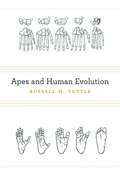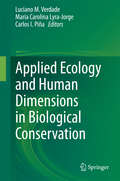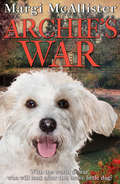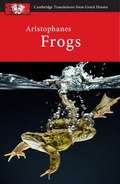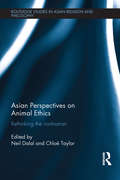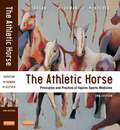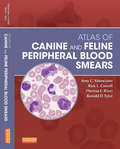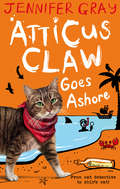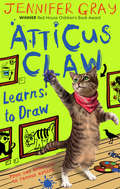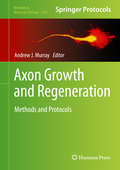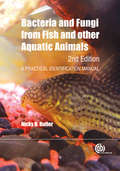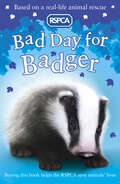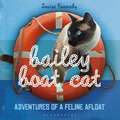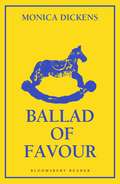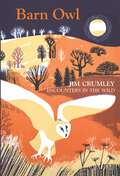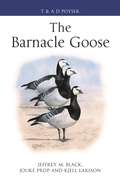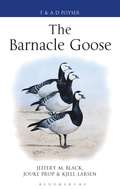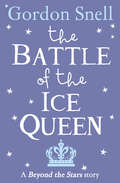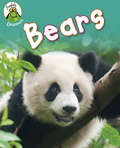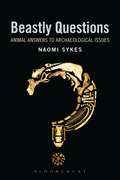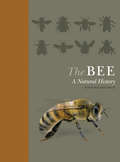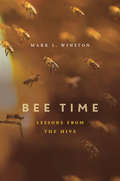- Table View
- List View
Apes and Human Evolution
by Russell H. TuttleIn this masterwork, Russell H. Tuttle synthesizes a vast research literature in primate evolution and behavior to explain how apes and humans evolved in relation to one another, and why humans became a bipedal, tool-making, culture-inventing species distinct from other hominoids. Along the way, he refutes the theory that men are essentially killer apes--sophisticated but instinctively aggressive, destructive beings. Situating humans in a broad context, Tuttle musters evidence from morphology and recent fossil discoveries to reveal what early primates ate, where they slept, how they learned to walk upright, how brain and hand anatomy evolved simultaneously, and what else happened evolutionarily to cause humans to diverge from their closest relatives. Despite our genomic similarities with bonobos, chimpanzees, and gorillas, humans are unique among primates in occupying a symbolic niche of values and beliefs based on symbolically mediated cognitive processes. Although apes exhibit behaviors that strongly suggest they can think, salient elements of human culture--speech, mating proscriptions, kinship structures, and moral codes--are symbolic systems that are not manifest among apes. This encylopedic volume is both a milestone in primatological research and a critique of what is known and yet to be discovered about human and ape potential.
Apes and Human Evolution
by Russell H. TuttleIn this masterwork, Russell H. Tuttle synthesizes a vast research literature in primate evolution and behavior to explain how apes and humans evolved in relation to one another, and why humans became a bipedal, tool-making, culture-inventing species distinct from other hominoids. Along the way, he refutes the theory that men are essentially killer apes--sophisticated but instinctively aggressive, destructive beings. Situating humans in a broad context, Tuttle musters evidence from morphology and recent fossil discoveries to reveal what early primates ate, where they slept, how they learned to walk upright, how brain and hand anatomy evolved simultaneously, and what else happened evolutionarily to cause humans to diverge from their closest relatives. Despite our genomic similarities with bonobos, chimpanzees, and gorillas, humans are unique among primates in occupying a symbolic niche of values and beliefs based on symbolically mediated cognitive processes. Although apes exhibit behaviors that strongly suggest they can think, salient elements of human culture--speech, mating proscriptions, kinship structures, and moral codes--are symbolic systems that are not manifest among apes. This encylopedic volume is both a milestone in primatological research and a critique of what is known and yet to be discovered about human and ape potential.
Applied Ecology and Human Dimensions in Biological Conservation
by Luciano M. Verdade Maria Carolina Lyra-Jorge Carlos I. PiñaThis book provides both the conceptual basis and technological tools that are necessary to identify and solve problems related to biodiversity governance. The authors discuss intriguing evolutionary questions, which involve the sometimes surprising adaptive capacity of certain organisms to dwell in altered and/or changing environments that apparently lost most of their structure and functionality. Space and time heterogeneities are considered in order to understand the patterns of distribution and abundance of species and the various processes that mold them. The book also discusses at which level—from genes to the landscape, including individuals, populations, communities, and ecosystems—men should intervene in nature in order to prevent the loss of biodiversity.
Archie's War
by Margi McAllisterA servant boy, a dog and a war that shook the world. Margi's latest has all its cannons blazing. Archie's family work on an aristocrat's country estate. When the First World War breaks out, Archie is asked to look after the dog of Master Edward, who has been called up to fight. An unbreakable bond soon grows between Archie and Star, the scruffy white terrier. So when Archie's big brother runs away to join the army, Archie and Star set off to find him. Facing many dangers, can they bring him home? A wonderful animal story and a great read for Remembrance Day.
Aristophanes: Frogs (Cambridge Translations From Greek Drama (PDF)Ser.)
by Judith Affleck Clive Letchford John HarrisonTreating ancient plays as living drama. Classical Greek drama is brought vividly to life in this series of new translations. Students are encouraged to engage with the text through detailed commentaries, including suggestions for discussion and analysis. Numerous practical questions stimulate ideas on staging and encourage students to explore the play's dramatic qualities. Frogs is suitable for students of Classical Civilisation and Drama. Features include a full synopsis of the play, commentary alongside translation for easy reference and a comprehensive introduction to the Greek Theatre. Frogs is aimed at A-level and undergraduate students in the UK, and college students in North America.
Asian Perspectives on Animal Ethics: Rethinking the Nonhuman
by Neil Dalal Chloë TaylorTo date, philosophical discussions of animal ethics and Critical Animal Studies have been dominated by Western perspectives and Western thinkers. This book makes a novel contribution to animal ethics in showing the range and richness of ideas offered to these fields by diverse Asian traditions. Asian Perspectives on Animal Ethics is the first of its kind to include the intersection of Asian and European traditions with respect to human and nonhuman relations. Presenting a series of studies focusing on specific Asian traditions, as well as studies that put those traditions in dialogue with Western thinkers, this book looks at Asian philosophical doctrines concerning compassion and nonviolence as these apply to nonhuman animals, as well as the moral rights and status of nonhuman animals in Asian traditions. Using Asian perspectives to explore ontological, ethical and political questions, contributors analyze humanism and post-humanism in Asian and comparative traditions and offer insight into the special ethical relations between humans and other particular species of animals. This book will be of interest to students and scholars of Asian religion and philosophy, as well as to those interested in animal ethics and Critical Animal Studies.
Asian Perspectives on Animal Ethics: Rethinking the Nonhuman
by Neil Dalal Chloë TaylorTo date, philosophical discussions of animal ethics and Critical Animal Studies have been dominated by Western perspectives and Western thinkers. This book makes a novel contribution to animal ethics in showing the range and richness of ideas offered to these fields by diverse Asian traditions. Asian Perspectives on Animal Ethics is the first of its kind to include the intersection of Asian and European traditions with respect to human and nonhuman relations. Presenting a series of studies focusing on specific Asian traditions, as well as studies that put those traditions in dialogue with Western thinkers, this book looks at Asian philosophical doctrines concerning compassion and nonviolence as these apply to nonhuman animals, as well as the moral rights and status of nonhuman animals in Asian traditions. Using Asian perspectives to explore ontological, ethical and political questions, contributors analyze humanism and post-humanism in Asian and comparative traditions and offer insight into the special ethical relations between humans and other particular species of animals. This book will be of interest to students and scholars of Asian religion and philosophy, as well as to those interested in animal ethics and Critical Animal Studies.
The Athletic Horse - E-Book: Principles and Practice of Equine Sports Medicine
by David R. Hodgson Catherine M. McGowan Kenneth McKeeverShowing how to maximize performance in horses, The Athletic Horse: Principles and Practice of Equine Sports Medicine, 2nd Edition describes sports training regimens and how to reduce musculoskeletal injuries. Practical coverage addresses the anatomical and physiological basis of equine exercise and performance, centering on evaluation, imaging, pharmacology, and training recommendations for sports such as racing and show jumping. Now in full color, this edition includes new rehabilitation techniques, the latest imaging techniques, and the best methods for equine transportation. Written by expert educators Dr. David Hodgson, Dr. Catherine McGowan, and Dr. Kenneth McKeever, with a panel of highly qualified contributing authors.Expert international contributors provide cutting-edge equine information from the top countries in performance-horse research: the U.S., Australia, U.K., South Africa, and Canada.The latest nutritional guidelines maximize the performance of the equine athlete.Extensive reference lists at the end of each chapter provide up-to-date resources for further research and study. NEW full-color photographs depict external clinical signs, allowing more accurate clinical recognition.NEW and improved imaging techniques maximize your ability to assess equine performance.UPDATED drug information is presented as it applies to treatment and to new regulations for drug use in the equine athlete.NEW advances in methods of transporting equine athletes ensure that the amount of stress on the athlete is kept to a minimum.NEW rehabilitation techniques help to prepare the equine athlete for a return to the job.Two NEW authors, Dr. Catherine McGowan and Dr. Kenneth McKeever, are highly recognized experts in the field.
Atlas of Canine and Feline Peripheral Blood Smears - E-Book: Atlas Of Canine And Feline Peripheral Blood Smears (Small Animal Laboratory Essentials)
by Ms, Dacvp, Rick L. Cowell, Dvm, Ms, Mrcvs, Dacvp Dvm, Ms, Dacvp, Rick L. Cowell, DvmAn illustrated guide to the morphology of blood cells, Atlas of Canine and Feline Peripheral Blood Smears covers patient assessment for common hematologic disorders and diseases in dogs and cats. Over 1,000 full-color photomicrographs depict abnormalities within each blood cell line, with multiple pictures of each morphologic abnormality and variations in their appearance. Written by pathology experts Amy Valenciano, Rick Cowell, Theresa Rizzi, and Ronald Tyler, this concise reference will enhance your skills as you interpret blood smears and recognize hematological cellular response to inflammation, infection, and toxicity. "Everything you might encounter looking at dog or cat blood smears is right there, clearly classified and noted (more than 1000 pictures!). Pitfalls and artefacts are clearly explained. The format (spiral binding) makes it the obvious accessory for your microscope. A good investment." Reviewed by: Vet's Today Date: July 2014Over 1,000 photomicrographs facilitate microscopic analysis and interpretation of the cellular components of the blood.Full-color, high-resolution images facilitate identification of different blood cell types, numbers, anomalies and conditions.Multiple representations of morphologic abnormalities aid in recognition of conditions where variations in appearance commonly occur.Practical information includes an overview of laboratory methods, equipment and supplies, sample collection, staining and handling, and diagnostic interpretation of blood smears.Coverage of 125 topics ranges from the morphology of erythrocytes to chronic myeloid leukemia. Spiral binding allows the book to lay open next to the microscope, making it a quick and easy reference while on the job.
Atticus Claw Goes Ashore (Atticus Claw: World's Greatest Cat Detective #4)
by Jennifer GrayAtticus is on beach tidying duty with the kittens when he finds a message in a bottle from Fishhook Frank. Fishhook is marooned on a desert island, but he promises Atticus treasure in exchange for his rescue! The treasure in question is the Casket of Desires, which contains a sleeping mermaid who has the power to grant any wish. But it is hidden in the deepest darkest part of the ocean, protected by the most hideous, fearsome sea-creatures known to pirate lore. Atticus sets out to rescue Fishhook Frank and find the Casket of Desires with his owners, the Cheddar family. But it's not all plain sailing. The pirate with the biggest beard-jumper in the nautical world - Captain Black Beard-Jumper - is also on the look out for the Casket and he'll curse anyone who gets in his way...
Atticus Claw Learns to Draw (Atticus Claw: World's Greatest Cat Detective #5)
by Jennifer GrayAtticus Claw Leans to Draw by Jennifer Gray is the latest in this popular series about master-criminal turned police-cat, Atticus Claw.Famous works of art are going missing. Atticus is on the case. The prime suspect is Ricardo Butteredsconi - Italian theme park entrepreneur and art connoisseur. Then Inspector Cheddar goes missing from the Tate Modern, and Atticus and his friends suspect Butteredsconi and his evil pet pig. In the scariest adventure of his nine lives, Atticus has to act fast if he wants to stop Inspector Cheddar becoming a waxwork!'Should be a hit for anyone who is, or has been, ten years old.' The Bookbag'Worth it for the delightfully feline puns alone.' Herald'As many ups and downs, triumphs and disasters, thrills and spills as ever.' Carousel'Atticus Claw is a masterpiece!' Sam, age 12'Very funny and interesting.' Aram age 9'Atticus is naughty and really cool!' Lucas, age 7'Atticus Claw is fantastic.' Charlotte, age 8
Axon Growth and Regeneration: Methods and Protocols (Methods in Molecular Biology #1162)
by Andrew J. MurrayAxon Growth and Regeneration: Methods and Protocols brings together a diverse set of techniques for the study of the mechanisms underlying central nervous system axon growth, consequently providing a resource that will aid in the development of repair strategies. After an introductory section, this detailed volume continues with sections focusing on axon growth in vitro, providing a range of protocols that can be used to examine intracellular signalling pathways, axonal responses to extracellular factors and methods for quantifying outgrowth. The next section provides protocols for inducing experimental injury in vivo as well as some highly promising protocols for promoting regeneration, which segues into the final section highlighting a series of protocols that can be used to monitor the extent of axon regeneration in vivo, ranging from tract tracing to in vivo imaging and functional recovery. As a book in the Methods in Molecular Biology series, chapters contain introductions to their respective topics, lists of the necessary materials and reagents, step-by-step, readily reproducible laboratory protocols and tips on troubleshooting and avoiding known pitfalls.Practical and reliable, Axon Growth and Regeneration: Methods and Protocols aims to serve researchers studying axon regeneration with a significant set of diverse tools, vital for moving on to the next generation of exciting new discoveries in the field.
Bacteria and Fungi from Fish and Other Aquatic Animals: A Practical Identification Manual
by Nicky BullerThis practical book provides an updated resource for the identification of bacteria found in animals inhabiting the aquatic environment, illustrated with colour photos. It contains expanded biochemical identification tables to include newly identified pathogenic and saprophytic bacteria, molecular identification tests now available for a greater number of aquatic bacterial pathogens, more information on the pathogenesis and virulence of each organism and new coverage of traditional and molecular identification of fungal pathogens and quality assurance standards for laboratories.
Bad Day For Badger (Rspca Ser. #9)
by Sarah HawkinsWhen Lewis and his dad see an injured badger on the side of the road they call the RSPCA. But when the RSPCA arrive to examine the young badger,she scampers under a parked car, only to get well and truly stuck! The RSPCA must work with the Fire and Rescue team to try and free the baby badger, and Lewis is going to do all he can to help.
Bailey Boat Cat: Adventures Of A Feline Afloat
by Louise KennedyBailey is a boat cat. He loves nothing more than cruising aboard Nocturne, gazing wistfully out of portholes, lounging on the sun deck wearing his cat lifejacket, climbing the mast and generally fulfilling his important boat-cat duties – and blogging about them at baileyboatcat.com. This book captures Bailey's charm with lovable photos, pearls of 'whisker wisdom' and cheeky asides, all from a cat's eye view. Chatty, inquisitive and boasting an undeniable cute factor, Bailey explains (for the benefit of us slow-witted humans) the five steps of marine navigation, the importance of cubby holes, and just why cats are so much cleverer than dogs…Packed with fabulous photography throughout, this endearing gift book will go down a treat with sailors and cat lovers alike.
Ballad of Favour
by Monica DickensThe summer is over and Rose Wood leaves the Wood Briar Hotel for school. Rose misses the summer buzz and her freedom from school, and with several weeks passing by quietly since her magical adventure with the Great Gray Horse she worries that her mission as the messenger of this ancient, brave horse is over.But when the mysterious composer, Mr Vingo, returns to the hotel, Favour, the Great Gray Horse reappears and Rose is summoned for another mission. This time she travels to an abandoned house in a town nearby where a forlorn family tries to survive their hardships. Will Rose and the horse be able to help them? Will Rose resist the temptation to share her secret with her friends, Abigail and Ben? She can only stay the messenger of the horse if she is brave and works undiscovered… The Ballad of Favour, is the second book in the four-part fantasy adventures series about Rose and the magical Great Grey Horse.
Barn Owl: Encounters in the Wild (Encounters In The Wild Ser.)
by Jim Crumley"An utter delight" Jennifer Tetlow. Renowned nature writer Jim Crumley gets up close and personal with some of Britain’s most iconic and loved animals - here, the barn owl.? The Encounters in the Wild series not only offers insights into their extraordinary lives, but also considers the conservation efforts to protect them and how the future looks for these much loved animals.
The Barnacle Goose
by Jeffrey M. Black Jouke Prop Kjell LarssonThe Barnacle Goose, a distinctive, handsome black-and-white bird, gets its name from a mediaeval myth that the birds hatched from barnacles – how else to explain their sudden appearance each autumn in northern Britain? We now know, of course, that the birds migrate from Arctic Russia, Norway and Svalbard to winter throughout northern Europe. This book represents a culmination of more than 25 years of Barnacle Goose research. It represents the story of one of Europe's most celebrated long-term behavioral studies, detailing the lives of these social and sociable birds. Chapters include sections on pair formation and bonding, family and population dynamics, brood parasitism, food and feeding, size and shape in different populations, life cycle, survivorship, dispersal, migration, and conservation, with particular regard to climate change. It is a rigorous and thorough examination of the lives of these birds, in fine Poyser tradition.
The Barnacle Goose
by Jeffrey M. Black Jouke Prop Kjell LarssonThe Barnacle Goose, a distinctive, handsome black-and-white bird, gets its name from a mediaeval myth that the birds hatched from barnacles – how else to explain their sudden appearance each autumn in northern Britain? We now know, of course, that the birds migrate from Arctic Russia, Norway and Svalbard to winter throughout northern Europe. This book represents a culmination of more than 25 years of Barnacle Goose research. It represents the story of one of Europe's most celebrated long-term behavioral studies, detailing the lives of these social and sociable birds. Chapters include sections on pair formation and bonding, family and population dynamics, brood parasitism, food and feeding, size and shape in different populations, life cycle, survivorship, dispersal, migration, and conservation, with particular regard to climate change. It is a rigorous and thorough examination of the lives of these birds, in fine Poyser tradition.
The Battle of the Ice Queen: Beyond The Stars
by Gordon SnellAn atmospheric short story taken from the collection, BEYOND THE STARS, written and illustrated by two great Irish talents in children’s fiction today
Bears (Froglets: Learners #1)
by Annabelle LynchFind out all about bears and their cuddly cubs, from gentle pandas to fierce polar bears.Froglets Learners offer fun facts in accessible text, perfect for building reading confidence.
Beastly Questions: Animal Answers to Archaeological Issues
by Naomi SykesZooarchaeology, or the study of ancient animals, is a frequently side-lined subject in archaeology. This is bizarre given that the archaeological record is composed largely of debris from human–animal relationships (be they in the form of animal bones, individual artifacts or entire landscapes) and that many disciplines, including anthropology, sociology, and geography, recognise human–animal interactions as a key source of information for understanding cultural ideology. By integrating knowledge from archaeological remains with evidence from texts, iconography, social anthropology and cultural geography, Beastly Questions: Animal Answers to Archaeological Issues seeks to encourage archaeological students, researchers and those working in the commercial sector to offer more engaging interpretations of the evidence at their disposal. Going beyond the simple confines of 'what people ate', this accessible but in-depth study covers a variety of high-profile topics in European archaeology and provides novel interpretations of mainstream archaeological questions. This includes cultural responses to wild animals, the domestication of animals and its implications on human daily practice, experience and ideology, the transportation of species and the value of incorporating animals into landscape research, the importance of the study of foodways for understanding past societies and how animal studies can help us to comprehend issues of human identity and ideology: past, present and future.
The Bee: A Natural History
by Noah Wilson-Rich Kelly Allin Norman Carreck Andrea QuigleyGenericBees pollinate more than 130 fruit, vegetable, and seed crops that we rely on to survive. Bees are crucial to the reproduction and diversity of flowering plants, and the economic contributions of these irreplaceable insects measure in the tens of billions of dollars each year. Yet bees are dying at an alarming rate, threatening food supplies and ecosystems around the world. In this richly illustrated natural history of the bee, Noah Wilson-Rich and his team of bee experts provide a window into the vitally important role that bees play in the life of our planet.Earth is home to more than 20,000 bee species, from fluorescent-colored orchid bees and sweat bees to flower-nesting squash bees and leaf-cutter bees. This book takes an incomparable look at this astounding diversity, blending an engaging narrative with practical, hands-on discussions of such topics as beekeeping and bee health. It explores our relationship with the bee over evolutionary time, delving into how it came to be, where it stands today, and what the future holds for humanity and bees alike.Provides an accessible, illustrated look at the human–bee relationship over timeFeatures a section on beekeeping and handy go-to guides to the identification, prevention, and treatment of honey bee diseasesCovers bee evolution, ecology, genetics, and physiologyIncludes a directory of notable bee speciesPresents a holistic approach to bee health, including organic and integrated pest management techniquesShows what you can do to help bee populations
Bee Time: Lessons from the Hive
by Mark L. WinstonBeing among bees is a full-body experience, Mark Winston writes. Bee Time presents his reflections on three decades spent studying these remarkable creatures, and on the lessons they can teach about how humans might better interact with one another and the natural world, from the boardroom to urban design to agricultural ecosystems.
Bee Time: Lessons from the Hive
by Mark L. WinstonBeing among bees is a full-body experience, Mark Winston writes. Bee Time presents his reflections on three decades spent studying these remarkable creatures, and on the lessons they can teach about how humans might better interact with one another and the natural world, from the boardroom to urban design to agricultural ecosystems.
